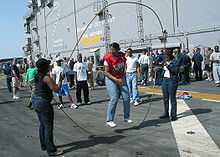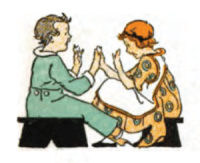Skipping rope

Skipping rope (British English) or Jump rope (American English) is the primary tool used in the game of skipping played by children and many young adults, where one or more participants jump over a rope swung so that it passes under their feet and over their heads. This may consist of one participant turning and jumping the rope, or a minimum of three participants taking turns, two of whom turn the rope while one ored beginning when the skipper jumps in and ending when the skipper messes up.
Jumping rope techniques


Some of the techniques that can be used when jumping rope are:
- Basic jump or easy jump
- The jumper keeps both feet slightly apart and jumps at the same time over the rope. Beginners usually master this technique first before moving onto more advanced techniques.
- Alternate foot jump (speed step)
- The jumper uses alternate feet to jump off the ground. This technique can be used to effectively double the number of skips per minute as compared to the above technique. This step is used for speed events.
- Criss-cross
- This method is similar to the basic jump with the only difference being that while jumping, the left hand goes to the right part of the body and vice versa for the right hand, with arms crossing in front of the body.
- Side Swing
- This is a basic technique where the rope passes the side of the skipper's body, without jumping it. Usually the skipper performs a basic jump after a side swing, or a criss-cross.
- EB(front-back cross)
- This is similar to the criss-cross except one arm crosses behind the back.
- Double under
- The participant jumps higher than usual while swinging the rope twice under his feet. It is possible to have the rope swing three times under the feet (triple under). In competitive jump rope, triples, quadruples ("quads"), and quintuples ("quins") are performed.
- Double Dutch
- In Double Dutch skipping, two long jump ropes turning in opposite directions are jumped by one or more players.
- Toad
- This is more complicated. The jumper performs the "Cross" manoeuvre with one arm crossing under the opposite leg from the inside.
- Leg Over
- The jumper skips in a normal open jump, but with one arm hooked under the same leg.
- Awesome Annie
- The jumper alternates between a Leg Over and a toad without a jump in between.
- Inverse toad
- This is similar to the toad, except the arm crosses the same leg from the outside (rather than the opposite leg from the inside).
- Elephant
- A cross between the inverse toad and the toad, where both arms cross under one leg, rather than one.
- Frog/Donkey kick
- This is a variation of a handstand, with a beginner version and an advanced version. In the beginner version, the jumper does a handstand, comes down and then pulls the rope under. In the advanced, the jumper pulls the rope while coming down from the handstand.
- Combination jumps
- There are many more difficult jump roping techniques that combine two or more of these techniques to make a single trick. These combinations can also be used in Chinese Wheel, Double Dutch, Egg Beater, triangle and Long Rope.
- The James Hirst
- This requires a more complicated technique. The jumper performs a backflip into a split and then back to a skip in the upright position.
- Other
- Other variations are possible. These include: "skier", a side-to-side jump keeping the feet together; "bell", a front-and-back jump keeping the feet together; "scissors", a jump putting one foot forward and the other back, then switching back-and-forth; "jumping jack", a jump putting the feet apart and then together; and "can-can" a jump with one leg up and bent, followed by a jump with both feet on ground, followed by a jump kicking the foot out. The possibilities are endless, and many Grand National champions have routines consisting of tricks they made up.
In competitive jump rope, competitors are required to have three elements in their routine: Multiple unders (when the rope passes under the feet multiple times in the air), strength or inversion/displacement, which consists of tricks utilizing a jumper's strength such as the frog/donkey kick, and rope manipulations, when one or both of the handles are released and caught, when jumpers cross the rope over their body, or when they wrap it around one of their limbs. Crosses, side swings, EB jumps, toads, and inverse toads are all examples of rope manipulations.
Health effects
Skipping as exercise
Skipping may be used for a cardiovascular workout, similar to jogging or bicycle riding. This aerobic exercise can achieve a "burn rate" of up to 700 calories per hour of vigorous activity, with about 0.1 calories consumed per jump. Ten minutes of jumping rope is roughly the equivalent of running an eight-minute mile. Jumping rope for 15–20 minutes is enough to burn off the calories from a candy bar.[1]
Weighted jump ropes are available for such athletes to increase the difficulty and effectiveness of such exercise. Individuals or groups can participate in the exercise, and learning proper jump rope technique is relatively simple compared to many other athletic activities. The exercise is also appropriate for a wide range of ages and fitness levels.
Competition
United States
Historically in the United States there were two competing jump rope organizations: the International Rope Skipping Organization (IRSO), and the World Rope Skipping Federation (WRSF). IRSO focused on stunt-oriented and gymnastic/athletic type jump rope moves, while the WRSF appreciated the aesthetics and form of jump roping. In 1995 these two organizations merged to form The United States Amateur Jump Rope Federation (USAJRF). USAJRF hosts annual national tournaments, as well as camps, workshops, and clinics on instruction. Jump rope is also part of the Amateur Athletic Union and participates in their annual AAU Junior Olympic Games.[2][3]
Performance on Television
There have been multiple jump rope troupes perform on major and renown talent shows and sports networks. The USA Jump Rope Grand National Championships were broadcast on ESPN. They had a contract with ESPN to showcase the sport, until 2010 when the contract was released.
In 2010 on season 5 of America's Best Dance Crew (ABDC), Saltare auditioned as a dance crew in the East. They made it past regionals and made it to Nationals. In week number five, they were eliminated, resulting in fifth place.
In 2011 on season 6 of America's Got Talent (AGT), the Summerwind Skippers, a jump rope team from Boise, Idaho auditioned and made it past the Vegas round and continued on to the Quarterfinals. They were eliminated during the week three results show, but were brought back by Piers Morgan for the Quarterfinals Wild Card Special. During this show, the Summerwind Skippers won the Judges' Vote to move on into the Semifinals, where they ended their journey.
Also, in season 9, in 2014 of AGT, Flight Crew Jump Rope auditioned and continued through the same journey that the Summerwind Skippers did. They made it past Judgement Week, into the first week of the Quarterfinals and were eliminated in the judges choice against Baila Conmigo. Though, for the first week of the Semifinals, Heidi Klum brought Flight Crew Jump Rope back as her one Wild Card pick. Though, disappointingly were eliminated and it was the end of the road.
See also
References
- ↑ "Jumping rope is cheap, portable, and burns more calories than you might think". WebMD. Retrieved 2007-07-29.
- ↑ "USA Jump Rope About Us". Retrieved 2012-09-05.
- ↑ "AAU Jump Rope Home". Retrieved 2014-04-01.
Further reading
| Wikimedia Commons has media related to Jump rope. |
